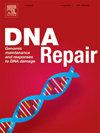一种新型NEIL1纳米体的研制与表征
IF 2.7
3区 生物学
Q2 GENETICS & HEREDITY
引用次数: 0
摘要
Nei核酸内切酶VIII-like 1 (NEIL1)是一种双功能的人类DNA糖基酶,通过识别和切除氧化碱基来催化碱基切除修复(BER)途径的第一步,包括胸腺嘧啶乙二醇和7,8-二氢-8-氧鸟嘌呤(8-oxoG)、spiroiminodihydantoin和guanidinohydantoin的进一步氧化产物。尽管NEIL1在维持基因组稳定性方面发挥着关键作用,但与OGG1、Polβ和APE1等其他BER蛋白相比,NEIL1的内源性细胞表达水平相对较低。因此,大多数细胞研究都依赖于过表达系统。此外,研究NEIL1的进展一直受到特定商业抗体不稳定的可用性和连续性的阻碍。为了解决这一挑战,我们开发了针对NEIL1的单域纳米体(vhs)。酵母2杂交(Y2H)筛选确定了10个VHH,其中最热门的候选基因(因此称为A5)多次出现。在这里,我们利用生物化学和分子技术的结合来表征A5的结合特性。差示扫描荧光法和糖基酶活性分析表明,重组A5特异性地稳定了重组表达的NEIL1,而不干扰其糖基酶活性。此外,我们的数据表明,A5优先结合NEIL1的n端糖基酶结构域,而不是其c端柔性尾,已知其介导蛋白-蛋白相互作用。在活细胞成像研究中,A5-mCherry染色体体与NEIL1- gfp共定位,并被招募到激光诱导的DNA损伤位点,这表明它有可能成为一种可视化NEIL1动力学的分子工具。这些发现确立了A5作为研究NEIL1功能的有价值的探针,并为探索其在DNA修复中的作用开辟了新的途径。本文章由计算机程序翻译,如有差异,请以英文原文为准。
Development and characterization of a novel NEIL1 nanobody
Nei endonuclease VIII-like 1 (NEIL1) is a bifunctional human DNA glycosylase that catalyzes the first step of the base excision repair (BER) pathway by recognizing and excising oxidized bases, including thymine glycol and the further oxidation products of 7,8-dihydro-8-oxoguanine (8-oxoG), spiroiminodihydantoin, and guanidinohydantoin. Despite its critical role in maintaining genome stability, NEIL1 is expressed at relatively low endogenous cellular levels compared to other BER proteins such as OGG1, Polβ, and APE1. As a result, most cellular studies have relied on overexpression systems. Additionally, progress in studying NEIL1 has been hindered by the inconsistent availability and continuity of specific commercially available antibodies. To address this challenge, we developed single-domain nanobodies (VHHs) targeting NEIL1. A yeast 2 hybrid (Y2H) screen identified ten VHH hits with the top candidate, henceforth called A5, emerging multiple times. Here, we characterize the binding properties of A5 using a combination of biochemical and molecular techniques. Differential scanning fluorimetry and glycosylase activity assays indicate that recombinant A5 specifically stabilizes recombinantly expressed NEIL1, while not interfering with its glycosylase activity. Moreover, our data suggest that A5 preferentially binds to NEIL1’s N-terminal glycosylase domain rather than its C-terminal flexible tail, which is known to mediate protein-protein interactions. In live-cell imaging studies, an A5-mCherry chromobody colocalizes with NEIL1-GFP and is recruited to sites of laser-induced DNA damage, suggesting its potential as a molecular tool for visualizing NEIL1 dynamics. These findings establish A5 as a valuable probe for studying NEIL1 function and opens new avenues for exploring its role in DNA repair.
求助全文
通过发布文献求助,成功后即可免费获取论文全文。
去求助
来源期刊

DNA Repair
生物-毒理学
CiteScore
7.60
自引率
5.30%
发文量
91
审稿时长
59 days
期刊介绍:
DNA Repair provides a forum for the comprehensive coverage of DNA repair and cellular responses to DNA damage. The journal publishes original observations on genetic, cellular, biochemical, structural and molecular aspects of DNA repair, mutagenesis, cell cycle regulation, apoptosis and other biological responses in cells exposed to genomic insult, as well as their relationship to human disease.
DNA Repair publishes full-length research articles, brief reports on research, and reviews. The journal welcomes articles describing databases, methods and new technologies supporting research on DNA repair and responses to DNA damage. Letters to the Editor, hot topics and classics in DNA repair, historical reflections, book reviews and meeting reports also will be considered for publication.
 求助内容:
求助内容: 应助结果提醒方式:
应助结果提醒方式:


